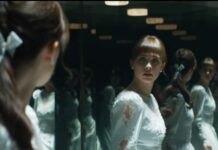
‘Out came this ginormous sound’: Hugh Padgham on ‘accidentally discovering’ the gated reverb drum sound
‘As is not unusual with innovations, it was not something those involved were looking for’
There are many fashion, cultural and music trends that sum up the 1980s but there is one sound in particular that almost epitomises the decade: the gated drum effect. Big, dramatic and bombastic but also sinister, it burst out of loudspeakers in 1980 and became ubiquitous on numerous rock and pop recordings, especially those of Phil Collins as artist and producer but also XTC, Duran Duran and its offshoot The Power Station, Bruce Springsteen and Kate Bush.
As is not unusual with innovations, it was not something those involved were looking for. It was more, says Hugh Padgham, the recording engineer and later producer who accidentally ‘discovered’ the effect, a combination of factors that created something so distinctive. This confluence happened in 1979 during the recording of Peter Gabriel’s third solo album at Townhouse Studios in west London.
Part of the Virgin Records group, along with residential studios The Manor in Oxfordshire, Townhouse opened in 1978. Padgham, a staff engineer at the time, explains that the initial two rooms were designed to be very different from each other. Studio 1 was in the traditional mould of The Manor, with a dead acoustic based on an Eastlake design and a Helios mixing console. Studio 2 was designed as a break from the norm, featuring two distinct acoustic spaces: a conventional sounding area and the very live ‘Stone Room’. The control room featured one of the first SSL B Series desks to be installed.
A feature of the B Series was an integrated reverse talkback circuit, which allowed those in the control room to hear the people in the studio as well as speak to them. In the Townhouse this was possible though a STC (BBC) 4021 ‘ball and biscuit’ dynamic omni-directional microphone fitted in the ceiling. This came into its own during the Gabriel sessions, on which the former Genesis frontman had invited his old band mate Phil Collins to play drums.
“One day Phil was playing in the studio and I inadvertently pressed the talkback button,” recalls Padgham. “Out came this ginormous sound, which everyone in the control room said sounded incredible. They all said, ‘Let’s have a bit of that on something’ but the problem was that because the talkback was built into the desk it couldn’t be recorded.”
To get round this Padgham asked the studios’ maintenance engineers to go into the console, take a feed from the talkback and put that into the jackfield so it could be patched back into the desk for recording. The next day the new effect was played to Gabriel, who decided to write a song round a treated pattern played by Collins. “We started recording and almost for a laugh I switched in a noise gate,” says Padgham. “That’s where the cut-off sound came from. So we now had something that sounded enormous but with no die away.”
This combination was the inspiration for the song Intruder, the menacing opening of Gabriel’s third album. Also known as ‘Melt’ because of its cover artwork, the recording is notable for not featuring cymbals, something Gabriel had already agreed with producer Steve Lillywhite and drummers Collins and Jerry Marotta. Padgham says this was just as well because of the gated reverb: “If there are cymbals at the same time it sounds like somebody hitting a giant dustbin. It completely annihilates the drums. If you want cymbals and the effect you have to overdub.”

Clearly impressed by the sound, Collins used it on his first solo album, Face Value (1981), which was also recorded in Townhouse’s Studio 2 with Padgham as assistant producer and engineer. It then featured on the Genesis single Mama (produced by Padgham and the band at The Farm) and ABBA vocalist Frida’s 1982-83 hit I Know There’s Something Going On, produced by Collins and engineered by Padgham at the Swedish group’s Polar Studios.
Padgham acknowledges the effect became something of an over-used cliche during the 80s. SSL incorporated the recording option into the E Series console, successor to the B, while digital processing developer AMS produced a program to mimic the sound, which Padgham helped refine. The definitive examples of gated reverb, however, are still those recorded in Studio 2 at Townhouse, which closed in 2008 and was later converted into luxury apartments. “I was devastated when they pulled it down,” says Padgham. But even though the room is gone, the sound it helped produce lives on. And on.
Source: mi-pro.co.uk












